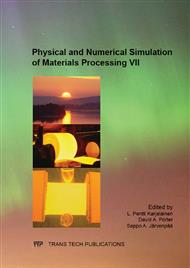p.405
p.411
p.418
p.424
p.431
p.437
p.445
p.451
p.457
Modelling Tensile Curves of AISI 316L at High Temperatures Starting from Strain Hardening Analysis
Abstract:
The tensile curves of AISI 316L deformed at temperatures between 700 and 1000 °C in the strain rates range 10-5-10-2 s-1 are modelled with the Voce equation, starting from strain hardening analysis. The parameters, needed to draw the Voce equation, are the saturation stress σV, the critical strain εC and the stress σo, that respectively define the height of the flow curve, the velocity to achieve σV and namely the back-extrapolated flow stress to zero strain. A two-parameter model of strain hardening recently proposed [ is used to analyze the strain hardening rate, dσ/dε, vs. the flow stress, σ. Through this analysis, σV, εC and the thermal activation of plastic flow s are obtained. In fact, the two-parameter model assumes that s and the total dislocation density ρ are the only two parameters needed to describe strain hardening. It has been reported [ that the parameter s can be parameterised in terms of strain rate and temperature and, furthermore, relationships between σV, σo, εC and s can be established. At this stage, the Voce equation can reproduce the experimental tensile curves at the explored temperatures and strain rates. However, the obtained Voce equations can well describe the tensile curves at large strains, while significant discrepancy occurs at small strains [. Preliminary results of an improved model based on two coupled differential equations with physical meaning are reported to correct this discrepancy at low strains.
Info:
Periodical:
Pages:
431-436
Citation:
Online since:
July 2013
Keywords:
Price:
Сopyright:
© 2013 Trans Tech Publications Ltd. All Rights Reserved
Share:
Citation:


